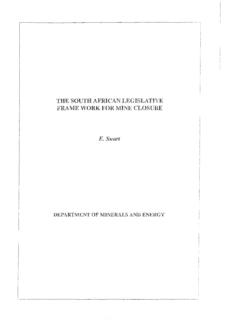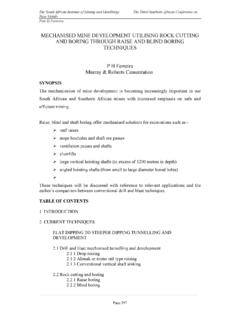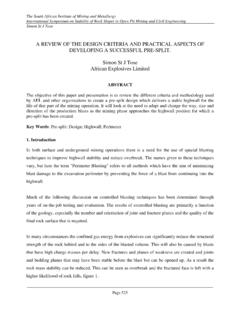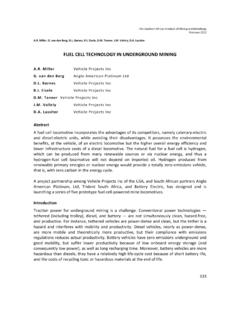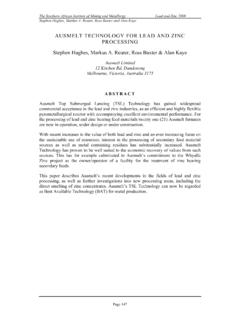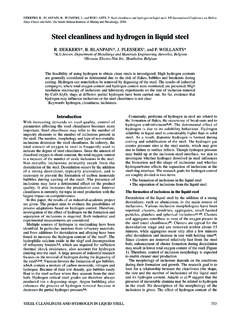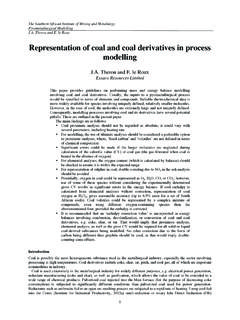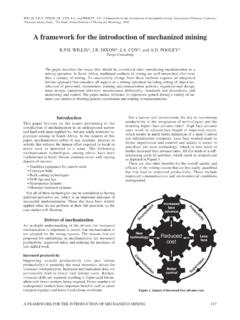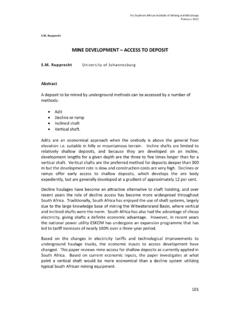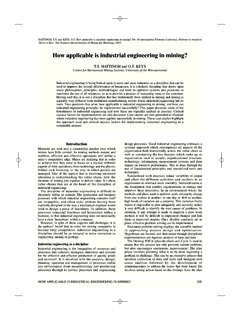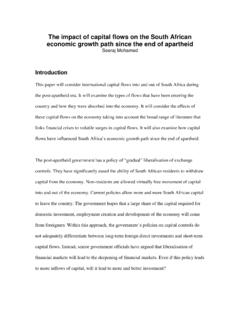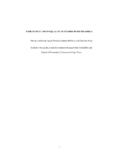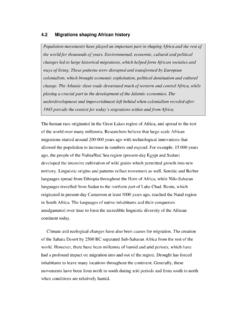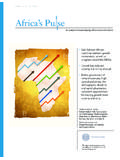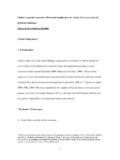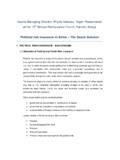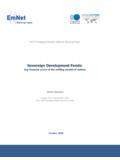Transcription of Platinum in the South African economy - SAIMM
1 Platinum IN THE South African ECONOMY1 IntroductionThis paper puts in perspective the contribution thatplatinum makes to the South African economy . In order todo this, it is necessary to understand the system of nationalaccounts (SNA) framework and its various is an integrated set of macroeconomic accounts,balances sheets and tables based on internationally acceptedconcepts (OECD 2004).In particular, it is necessary to understand input-output(IO) tables, supply and usage (SU) tables and grossdomestic product (GDP).The paper uses data from official sources, namely theSouth African Reserve Bank, the Department of Mineralsand Energy, the SARS Department of Customs and Excise,and Statistics South few people are aware of this data, especiallythe SU tables, published by Statistics South Africa (SSA),and the trade statistics, published by the Customs andExcise division of the South African Revenue Service.
2 Thepaper therefore contains a concise explanation of thesedocuments, as well as the derivation of gross domesticproduct (GDP) and an outline of the System of NationalAccounts, of which SU Tables are components. GDP is a commonly used, but poorly understood,measure of the wealth of an economy . The paper explainsthe methods used by SSA to calculate this indicator and itsplace in the System of National Africa exports almost all its Platinum to data published by the Department of Mineralsand Energy, South Africa exported Platinum worth out of total production worth bn in 2002( ). However, data from the Customs and Excisedivision of the South African Revenue Service indicatesthat exports were slightly less, at bn.
3 Gold remainsthe highest value export at bn and bn,according to data published by the Department of Mineralsand Energy and Customs and Excise, are a final demand, as opposed to intermediatedemand from secondary industries, and therefore do notenter the value-adding process, which is the essence ofGDP. By definition, therefore, neither Platinum nor gold,on their own, are major contributors to the Platinum and the gold industries do, however,have an impact (known as the multiplier effect) on othersectors of the economy . The paper explains the meaningand derivation of these multipliers, using a model based onan inverse Leontief matrix.
4 This model uses anothercomponent of SNA, , input-output (IO) , South Africa discontinued the use of IOtables in 1999, and the multipliers are not current. The system of national accountsIn 1936, John Maynard Keynes examined the relationshipsbetween production, consumption, savings and investment,and developed the General Theory of Employment, Interestand Money (Keynes, 1936). Building on these theories, several economists publisheda System of National Accounts, or SNA, in 1953. SNA isprobably one of the most important developments intwentieth-century economics, and is a main macro-economic building block that frames economic analysis andpolicy (SA Reserve Bank, 1999).
5 STILWELL, Platinum in the South African economy . International Platinum Conference Platinum Adding Value ,The South African Institute ofMining and Metallurgy, in the South African STILWELLRead, Swatman & Voigt (Pty) LtdThe paper will place into perspective the contribution that Platinum makes to the South Africaneconomy. It will use statistics from official sources, namely the Department of Minerals andEnergy, the Department of Customs and Excise, the South African Reserve Bank and StatisticsSouth few people are aware of these statistics, especially Supply and Usage tables,published by Statistics South Africa, and trade statistics, published by the Customs and Excisedivision of the South African Revenue Service.
6 The paper will therefore contain a conciseexplanation of input-output tables and supply usage tables, as well as the derivation of grossdomestic product and an outline of the System of National Accounts, of which Input-OutputTables and supply and usage tables are is a commonly used, but poorly understood, measure of the wealth of an economy . Thepaper will explain the methods used by SSA to calculate this indicator and its place in the Systemof National Accounts (SNA). South Africa exports almost all its Platinum production ( in 2002). Exports are a finaldemand, as opposed to intermediate demand from secondary industries, and therefore do not enterthe value-adding process, which is the essence of GDP.
7 By definition, therefore, Platinum on itsown is not a major contributor to Platinum industry does, however, have an impact (known as the multiplier effect) on othersectors of the economy . The paper will explain the meaning and derivation of these multipliers,using a model based on an Inverse Leontief ADDING VALUE2In 1993, five international organizations (theOrganization for Economic Co-operation and Development,the United Nations Statistical Division, the InternationalMonetary Fund, the World Bank, and the Statistical Officeof the European Communities) jointly published a majorrevision of the System of National Accounts, calledSNA93, based on internationally agreed concepts,definitions, classifications and accounting rules.
8 SNA93 is adetailed framework that produces a coherent, consistent andintegrated set of macroeconomic accounts, balance sheetsand tables. It presents a great mass of information about theworking of an economy , especially the economic indicator,gross domestic product, or GDP (OECD 2004). South Africa has used a form of national accounting since1922, when Lehfeldt published estimates of SouthAfrica s national income, but it was not until 1947 that theBureau of Census and Statistics (a forerunner of the presentStatistics South Africa) published official estimates ofdomestic and national income. Soon after 1950, the SouthAfrican Reserve Bank published a set of annual nationalaccounts.
9 The first set of quarterly accounts appeared in theMarch 1971 issue of the Bank s Quarterly Bulletin(SAReserve Bank, 1999).Input-output tables and Supply and UsagetablesInput-output tablesIn 1936, Vassily Leontief, a Russian born American,published the first input-output tables. In 1973, he receivedthe Nobel Prize for Economics for this work. AlongsideSNA, which they pre-date, IO tables are one of thetwentieth century s major advances in economics. Theyallow analysis of an economic system using real numbers,instead of complicated economic formulae, and arenumerical models of the relationships between theproduction sectors of an economic system.
10 By showingdetails of the flow of goods and services between sectors,they provide an analysis of the production process, the useof these goods and services and the income generated in theproduction tables have a square matrix format, ,equal numbers of rows and columns, showing all thesectors in an economic system. They are a vital part of thenational accounting system, and incorporate the productand expenditure accounts, which form the cornerstone ofthe SNA.(SARB 1999)A set of IO tables published by Statistics South Africa,the government agency authorized to compile and publishofficial statistics, consists of three separate tables, , A transaction table, that shows the value of transactionsbetween industries at basic prices* An input coefficient table, that shows the directrequirements of each industry in relation to its output,or the input necessary to produce one rand of output An inverse or total requirement table, which shows thetotal direct and indirect requirements per rand of outputdelivered to final demand.
